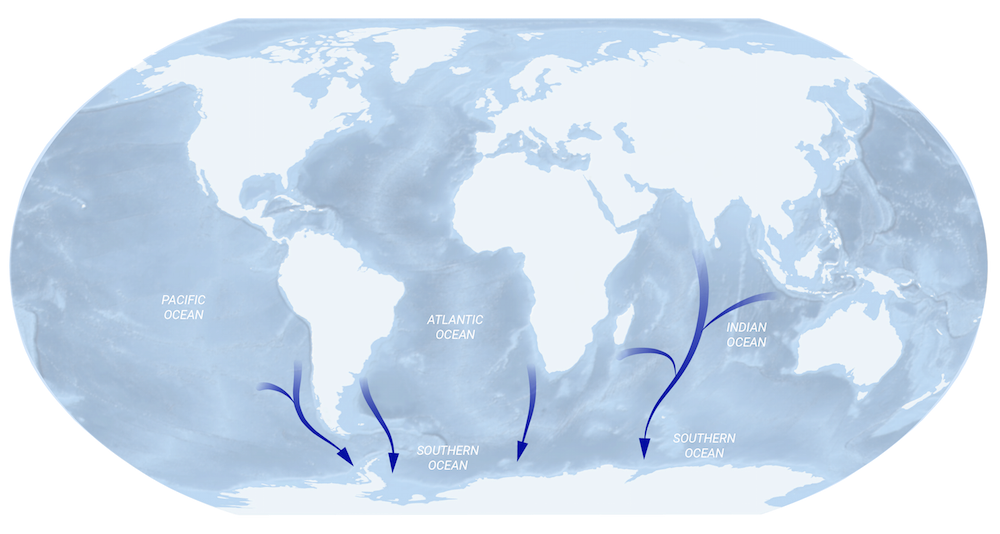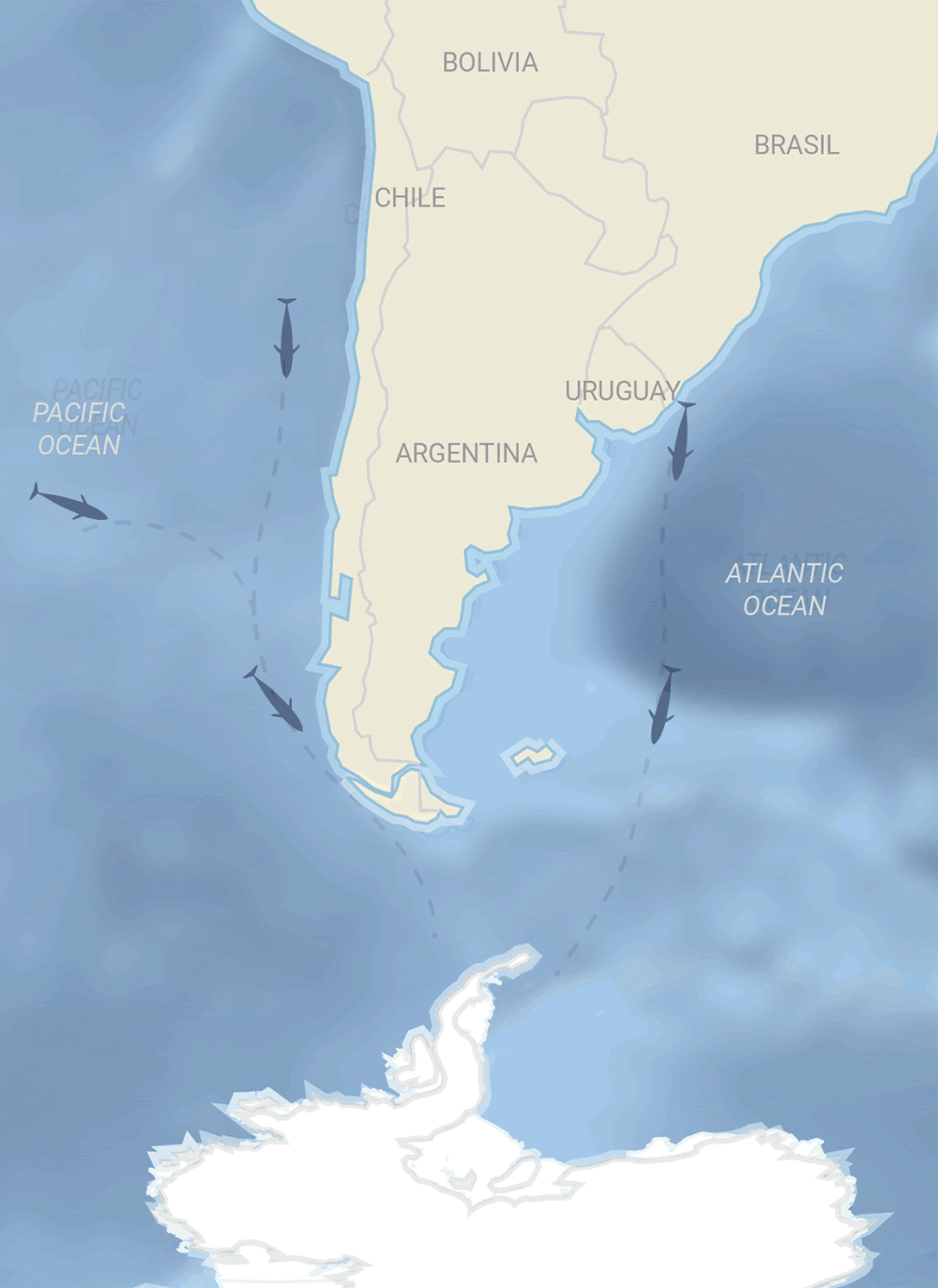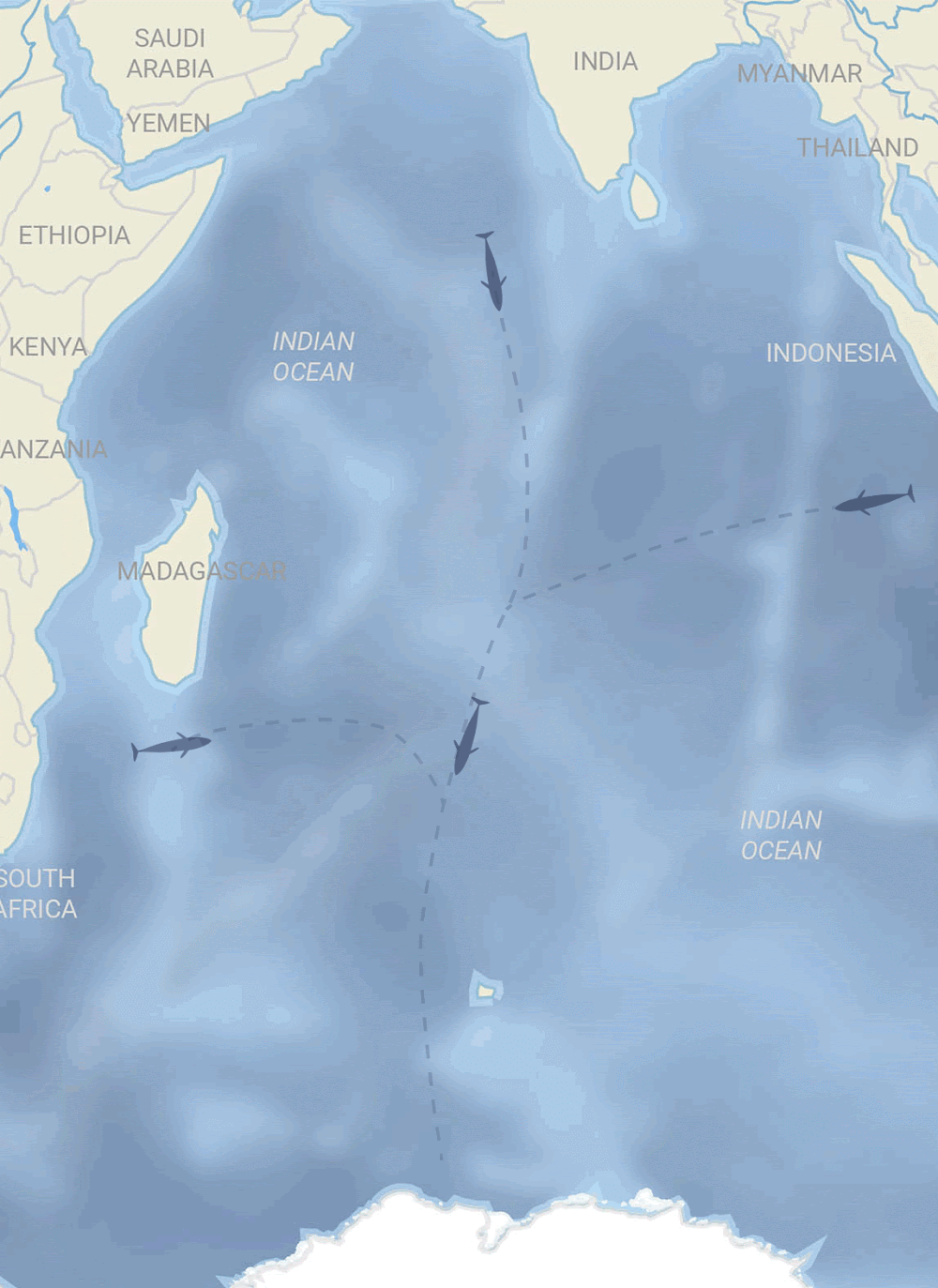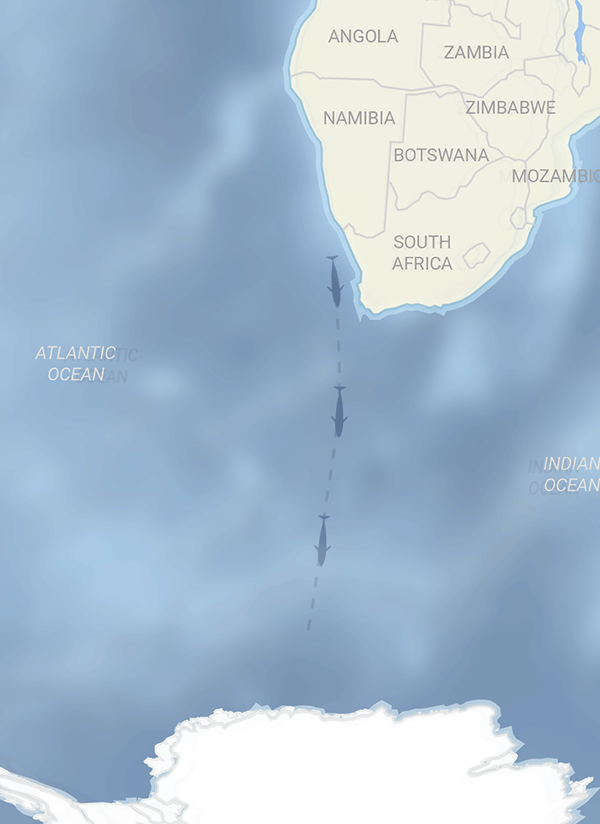BLUE WHALES AND THEIR SEMI-ANNUAL MIGRATIONS IN the Southern Hemisphere
With their magnificent figures and majestic appearances in different regions around the world, blue whales are distinct not only because of their gigantic presence but because their well-formulated migration routes for feeding and reproducing have given the curious minds from all over the world the opportunity to have a glimpse at the nature’s wonder. However, regardless of their magnificent figures, they are the world’s one of the most endangered species.
To talk about the blue whales' semi-annual migrations, some insights on their life cycle need to be mentioned. Blue whale grows into a size of 15 m from an 8 m calf in 7 - 8 months period and is ready to migrate alone. They reach sexual maturity in 5-10 years which indicates the need for mating and migrating for reproduction.

Blue whales are widely distributed all over the world, generally in deeper sea waters instead of in shallow coastal water. Generally speaking, in summer, blue whales migrate towards the Poles (both North and South) into the cooler water to feed. They migrate towards regions called frontal zones, where different water masses meet and mix. In these regions, through mixing of seawater, nutrients from deep sea are brought up, stimulating the growth of phytoplankton and supporting the reproduction of prey species, such as krills, for whales to feed on. In winter, blue whales migrate back towards the equator where water is warmer for reproduction. Since the seasons in North and South Hemisphere are opposite, the blue whale population in each Hemisphere do not mix usually.
BLUE WHALES MIGRATION IN THE SOUTH HEMISPHERE: from SOUTH AMERICA TO ANTARCTICA
 One of the three most important migration routes of blue whales are the ones from South America to Antarctica Peninsula. The well-known habitat for blue whales are are Chile and Argentina in the Peninsula Valdes. Based on the Huffingtonpost’s recommendations on best whale-watching spots in Latin America, the island of Chiloé in Chile is high up in the board because a large population of blue whales resides here from late January to April. Other regions in South America could also be great locations for observing and witnessing these migration events. In the coastal town of Puerto Madryn on Patagonia’s rugged Peninsula Valdes in Argentina, blue whales appear feet away from the shore from June to December. Other sea creatures are also extra active at this time, such as seals, sea lions, etc.
One of the three most important migration routes of blue whales are the ones from South America to Antarctica Peninsula. The well-known habitat for blue whales are are Chile and Argentina in the Peninsula Valdes. Based on the Huffingtonpost’s recommendations on best whale-watching spots in Latin America, the island of Chiloé in Chile is high up in the board because a large population of blue whales resides here from late January to April. Other regions in South America could also be great locations for observing and witnessing these migration events. In the coastal town of Puerto Madryn on Patagonia’s rugged Peninsula Valdes in Argentina, blue whales appear feet away from the shore from June to December. Other sea creatures are also extra active at this time, such as seals, sea lions, etc.
BLUE WHALES MIGRATION IN THE SOUTH HEMISPHERE: from Southern Indian Ocean TO ANTARCTICA
 Some of the three most important migration routes of blue whales in the Southern Hemisphere are the ones from Southern Indian Ocean (35–50°S) to Antarctica. The highest sighting rates of blue whales were recorded between 40°S and 55°S in the southern Indian Ocean and south of Australia. Among all the blue whales sighted in the ocean of this region, a small portion is the larger Antarctic blue whale, more commonly sighted are the smaller Pygmy blue whales. Nowadays, the blue whale migration from Southern Indian Ocean to Antarctica is not as large in scale comparing to other routes in different parts of the world. As matter of fact, their population is estimated to be only in the hundreds in the Southern Indian Ocean. In Northern Indian Ocean, there is another population of blue whales, but their migration patterns contrast the ones in the South, they migrate towards the Arctic ocean instead of towards the Antarctica, so they are not likely to meet.
Some of the three most important migration routes of blue whales in the Southern Hemisphere are the ones from Southern Indian Ocean (35–50°S) to Antarctica. The highest sighting rates of blue whales were recorded between 40°S and 55°S in the southern Indian Ocean and south of Australia. Among all the blue whales sighted in the ocean of this region, a small portion is the larger Antarctic blue whale, more commonly sighted are the smaller Pygmy blue whales. Nowadays, the blue whale migration from Southern Indian Ocean to Antarctica is not as large in scale comparing to other routes in different parts of the world. As matter of fact, their population is estimated to be only in the hundreds in the Southern Indian Ocean. In Northern Indian Ocean, there is another population of blue whales, but their migration patterns contrast the ones in the South, they migrate towards the Arctic ocean instead of towards the Antarctica, so they are not likely to meet.
BLUE WHALES MIGRATION IN THE SOUTH HEMISPHERE: from SOUTHERN AFRICA TO ANTARCTICA
 Dr. Ken Findlay, the Director of the Whale Unit, which is based in Cape Town, has indicated that the ocean in South of Africa (0–70°E), also known as IWC, the International Whaling Commission Management Area III, has the largest number of whales during Southern Hemisphere summer. It is estimated by the IUCN Red List of Threatened Species that around 8000 blue whales habit in the ocean South of Africa. It is likely that many blue whales in the region’s water encounter in Area III and migrate Northward during South Hemisphere winter as well, which has made this region a historical hunting ground of whales by humans.
Dr. Ken Findlay, the Director of the Whale Unit, which is based in Cape Town, has indicated that the ocean in South of Africa (0–70°E), also known as IWC, the International Whaling Commission Management Area III, has the largest number of whales during Southern Hemisphere summer. It is estimated by the IUCN Red List of Threatened Species that around 8000 blue whales habit in the ocean South of Africa. It is likely that many blue whales in the region’s water encounter in Area III and migrate Northward during South Hemisphere winter as well, which has made this region a historical hunting ground of whales by humans.
Despite the bloody history of whaling in the region, many places along the coast of Africa has become today’s top whale watching spot. Hermanus, a town in the South tip of Africa, is one of the best shore-based whale watching spot, along with their unique equipment, whale crier, to attract whales. Generally speaking, July to November is a good time for catching a glimpse of these magnificent creatures in Africa.
Blue Whales and Antarctic Krills
 Image from Wikimedia Commons.
In their migration, the Western Antarctic sector of the Southern Ocean is the regular feeding ground of a large number of whales of different species. Blue whales migrate to Antarctica to feed on one single most important animals, Antarctic Krill, which has the size approximate to a pinky. It is often surprising to people that th-is world’s largest creature is so dependent on such a small animal. During the 8 months of feeding in an entire year, an adult blue whale can consume krills up to 3-4% of their own body weight a day. That is, for a blue whale that weighs 150 tons, it consumes 6 tons, or 6 million krills a day. Therefore, making Antarctic Krills the key food resource and the critical forerunner to indicate blue whale population.
Image from Wikimedia Commons.
In their migration, the Western Antarctic sector of the Southern Ocean is the regular feeding ground of a large number of whales of different species. Blue whales migrate to Antarctica to feed on one single most important animals, Antarctic Krill, which has the size approximate to a pinky. It is often surprising to people that th-is world’s largest creature is so dependent on such a small animal. During the 8 months of feeding in an entire year, an adult blue whale can consume krills up to 3-4% of their own body weight a day. That is, for a blue whale that weighs 150 tons, it consumes 6 tons, or 6 million krills a day. Therefore, making Antarctic Krills the key food resource and the critical forerunner to indicate blue whale population.
Antarctic Krills are very sensitive to the change in climate. They feed on large phytoplankton (diatom), grow and mature underneath the Antarctic ice sheets. Every year, the seasonal change of solar radiation, temperature, and wind lead the large water bodies of different temperatures to meet and mix in the Southern Ocean region. This mixing of water overturns the nutrients from the deep ocean upwards, feeding the phytoplankton community, which in turn sustains the krill population.
CLIMATE CHANGE INDUCED KRILL DECREASE CHANGES BLUE WHALE MIGRATION
Having been discussed above, the Antarctic Krill is a vital species in the Southern Ocean ecosystem that these largest animals, blue whales, travel across the globe to feed on them almost solely. This makes krills one of the most influential factors on the blue whale population, in addition to human whaling activities.
The first devastation brought by climate change is the increase in water temperature and possible alteration in wind patterns. These factors could reduce the extent of ocean water mixing, and change the ocean stratification, thus, influencing the distribution and availability of nutrients that the phytoplankton feed on and furthermore, the productivity and distribution of krills. Secondly, the krill larval grow and mature underneath the ice sheets, where the temperature is moderate but sunlight is sufficient. This is another direct influence on krill population because as the climate warms, sea ice extent reduces thus a shrinkage in krill habitat. The third possible devastation is related to the sea ice duration. As the climate warms, not only the extent of the sea ice reduces but also sea ice formation delays, which could lead the life cycle of the krills to be forced to change, as well as the possible premature death of a large number of krill larvae. Besides these environmental changes, human’s harvesting of krills could devastate the krill population even further.
Along with other environmental changes led by global warming, including an increase in the occurrence of climate anomalies (such as El Niño and La Niña), ocean acidification, etc., these changes all directly or indirectly influence the production of phytoplankton, as well as the krill and whale population, thus, influences the entire food chain. All of these environmental changes could push the already endangered blue whale population to even close to extinction. Again, with krills being their most important prey, blue whales face severer challenges when the krill population decreases.
With the hope of inspiring more people to realize the consequence that climate change has on the Southern Ocean ecosystem and take action, we have simulated this food chain in the following interactive map. Please note that the statistics indicated in this map are only speculations based on scientific research.